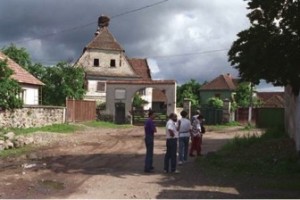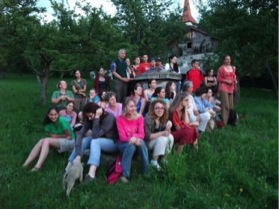From 2010, camps organised for the assessment of cultural values of settlements outside Hungary’s borders are arranged by the CentrArt Association. They are coordinated professionally by the National Office of Cultural Heritage (KÖH), with the participation of art history and architecture students from Hungary and Transylvania.
It is our responsibility as well, to preserve the cultural heritage of Hungarian inhabited territories outside Hungary’s borders. However, the knowledge of architectural monuments and material relics is indispensable for its protection – and also its continuous research and exploration. Programmes for the survey of cultural values could officially begin in the 1990s, following the political transformation of Eastern Europe: Firstly, in the Hungarian inhabited settlements of Transylvania, as a collaboration of Hungarian, Transylvanian and German experts. It was coordinated by József Sebestyén from the former Hungarian Office for the Protection of Historical Monuments (legal predecessor of the National Office of Cultural Heritage). The documentation of the architectural values of the first region, Erdővidék began in 1997, in connection with a successful tender. It was modelled on previous surveys of Transylvanian Saxon settlements. The project was also supported by the European Commission.
1997 – Survey of Erdőfüle with experts from Szeklerland (In the background: The Boda-mansion)
Photo: József Sebestyén
Professionals from several academic and architectural workshops from Transylvania participated in the preparations of the survey. However, the field-work and the documentation itself were carried out by the art history students of the Babeş-Bolyai University Kolozsvár/Cluj-Napoca (BBTE), led by the art history professor András Kovács. In addition to the survey of the Erdővidék region, in 1999, a small group of art history students from the Eötvös Loránd University Budapest (ELTE) joined in to compile a list of church goods. In 1998-1999, the students from Kolozsvár continued the work by accessing the Upper-Nyárád river region, and then in the following years, they worked in the settlements along the Homoród river, in Lower Csík and Upper Háromszék, in which also the students of the ELTE took part. (Similar initiatives were started in the former Yugoslavia, parallel to the surveys in Transylvania, in the Vojvodina and the Mura-region. You can read more about the programme in a study by József Sebestyén in the conference volume in “Colligite Fragmenta! Protection of Cultural Heritage in Transylvania”.)
1999 – Students from the ELTE Budapest – Imola Gebauer, Dóra Mérai, Ágnes Tóvizi, Réka Várallyay – assessing property/assets in the Erdővidék region.
Photo: Imola Gebauer
The field-work was a decisive experience for the participating students. A lot of data was accumulated, but this material has still not yet arrived at the local governments, so as to include the results into their regulation plan, or to give a local protection status to the more precious buildings. The correction and the review of data sheets that were accumulated during the survey within a short time-span, but on a large territory, in many settlements, took quite a long time, since the students had not yet enough experience in describing the buildings.
By making use of earlier experiences, in 2005 we worked out a new strategy to continue the survey of cultural values. As a member of the Division for Hungarian Heritage out of Hungary of the National Office of Cultural Heritage and PhD student of the ELTE Doctoral School of Art History, together with Renáta Herczeg, I laid a great emphasis on teaching second- and third-year students how to describe buildings and on the field-work as well. Due to the good professional and human ties that prevailed with Fülek/Fil’akovo in Southern Slovakia, a city less than 10 km-s away from the Hungarian border, in August 2005, we started the survey of cultural values of the town as well as the art historical research and the architectural assessment of the more significant buildings. Approximately fifteen art history and ten architecture students took part in the project. It was supported by the National Monument and Archaeology Special College of the National Cultural Fund (of Hungary). The week spent in the Hungarian Community’s House below Fülek castle was a great success. The local people organised numerous programmes, including lectures, the display of old postcards, dances and camp-fire evenings. We presented our results on a conference on the spot and a couple of months later at the ELTE Art History Department in Budapest, which where a source of many studies and articles by students and even thesis paper was written on it. Since then, we have continued the Fülek camp with an assessment of the cultural values of the surrounding settlements. We survey the settlements by employing a data sheet used by the National Office of Cultural Heritage for the topographical surveys in Hungary, on the basis of the INTERSAVE method. Every summer, excursions take place to two to three small villages and they are also documented. On the basis of previous years’ data, the architectural survey of valuable and endangered houses is undertaken. The data sheets and the photodocumentation arrive at the Municipal Building Office of Fülek, in order to be included in the local regulation plan. In 2008 and 2009, the camp was led by Erzsébet Arany, in the summer of 2010 – during the 6th camp organised for the survey of cultural values around Fülek – by Anita Nagy.
Alongside the survey of cultural values in former Upper Hungary, we also continued those begun in the Transylvanian Szeklerland. In the summer of 2007, the Association of the Pogány-havas micro-region requested the Division for Hungarian Heritage out of Hungary, to help it with survey-work and documentation, necessary for their village preservation programme. The excursion to the micro-region comprising the settlements of the Upper Csík and Gyimes area was a great challenge. The processing of data accumulated during the joint work of the students of ELTE and BBTE was led by Renáta Herczeg. In October 2007, the results were presented to the micro-region during a conference.
One of the most important projects of the past years was the survey of the Sepsiszék and Orbaiszék area settlements in the historical Háromszék county. In the summer of 2008, a detailed survey of Bikfalva took place, in 2009 Árkos, and in 2010 Uzon, Lisznyó and Sepsimagyarós followed. In connection with the assessment of Bikfalva, a map was made that shows the buildings recommended for local protection, on which the manor-houses also appear. The students completed an already existing survey from 1996, by supplementing the photodocumentation and recording the details of the inner rooms: the inscriptions of the carved beams, valuable details and mementos of its owners. In the camp organised in 2008, altogether nine institutions from Transylvania and Hungary took part, with almost forty students: apart from art historians, architecture students of the Budapest University of Technology and Economics (BMGE), there were also pupils of technical schools for the building trade, who did the architectural survey and charted the local cemetery.
In February 2010, the local government of Uzon (to which Bikfalva also belongs) ordered a study necessary for the local decree about the protection of cultural heritage of this beautiful little village. This will lead to a resolution by the local council about the protection of the local values of Bikfalva, hopefully setting an good example not only for the county, but for the entire Szeklerland.
We invite all art history students and graduates, to join us in this year’s survey of cultural values, to get to know the countryside around Fülek or a small part of Transylvania, and to contribute to the task of making cultural values being known and saved!


